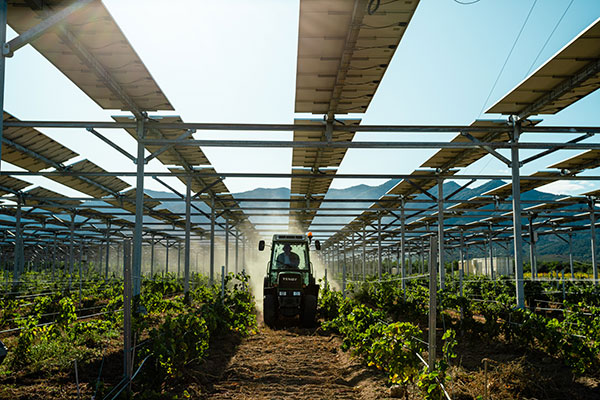
While the mild winter favoured early plant growth, spring frost occurred just as the crops were starting to bud, forcing farmers to find sometimes costly ways to protect them. According to 2020 data from the vineyards of the Domaine de Nidolères in Tresserre in the south of France, the plants under Sun’Agri technology avoided periods of spring frost, while those on the control plot did not.
Spring frost is a frequent risk in agriculture and threatens the buds in particular. In mid-winter, when the buds have not yet emerged, the plant is dormant, allowing it to withstand low temperatures (down to about -15°C). By early spring, however, once the buds have resumed visible activity (they are no longer dormant, i.e. the buds have opened and have started to produce new leaves for the season), they are very sensitive. If the temperature drops below -2°C, the buds may fail, thus threatening that year’s production.
There are a number of solutions for mitigating the effects of frost: anti-freeze towers that stir the air, spraying water to form a protective layer of ice, installation of heaters or candles on the plots, heating wires, etc. However, these devices often represent significant financial and human resources investments for farmers.
On average, the temperature of vines protected by agrivoltaic systems is 2°C higher.
Dynamic agrivoltaics, a ground-breaking technology that protects agricultural crops against climate risks, represents an alternative to existing solutions. The louvre control strategies developed by Sun’Agri include protection against spring frost: when temperatures drop and threaten the well-being of the crop, the agrivoltaic panels are positioned horizontally, parallel to the ground, so that they cover almost 40% of the total area. At night, this helps to retain the heat stored in the soil during the day until dawn. These extra couple of degrees are particularly beneficial when the temperature approaches 0°C: they prevent frost and therefore protect the most sensitive parts of trees and vines, such as the buds and flowers.
During the 2020 cold spells, the vines on the 4.5-hectare area of the Domaine de Nidolères covered by solar louvres registered average temperature gains of 2°C , protecting the crops from frost.
“The 2020 data highlight the real benefits of dynamic agrivoltaics in protecting crops from spring frost and position the technology as a solution for adapting and protecting agriculture from climate change,” says Antoine Nogier, President and founder of Sun’Agri.
Using dynamic agrivoltaics to adapt agriculture to climate change
Agrivoltaics is a tool for protecting crops from weather hazards, whereby mobile solar louvres are placed above the plants at sufficient height to enable agricultural machinery to pass. These solar louvres are placed at the service of the plant; controlled by algorithms tailored to agronomic needs, they tilt to provide sunlight or shade, as required. The main aim is to enable farmers (such as wine or fruit growers) to achieve their production targets, both in terms of quality and quantity, even in the face of weather hazards that threaten their crops.
Sun’Agri is a pioneer of this technology, which makes it possible to modify the microclimate of crops in real time by adjusting the solar louvres.
